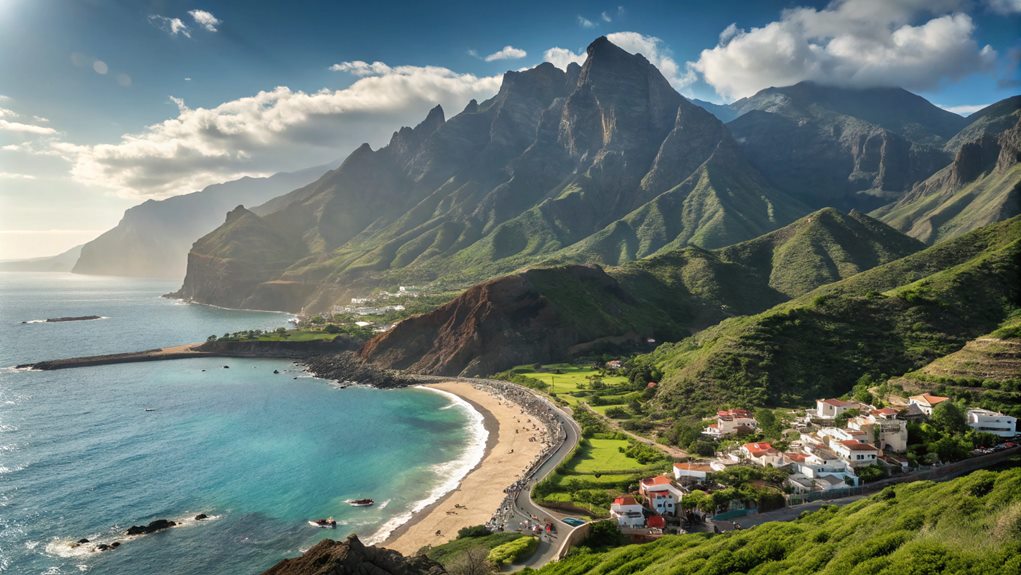While the Canaries may dazzle with their Spanish charm, you’ll find that Cape Verde’s hidden African paradise outshines its rival. This enchanting archipelago blends mesmerizing cultures, untamed natural beauty, and an authenticity that sets it apart. Imagine sun-drenched beaches, dramatic volcanic landscapes, and vibrant Creole rhythms. Immerse yourself in local festivals, savor the fusion cuisine, and discover eco-friendly adventures. Sure, getting there might take a bit more effort, but that’s all part of the thrill. Intrigued? Keep reading to uncover why Cape Verde deserves the spotlight as a truly remarkable travel destination.
Key Takeaways
- Cape Verde offers a more authentic cultural experience with its vibrant Creole heritage, morna music, and traditional cuisine like cachupa, compared to the more Europeanized Canary Islands.
- While the Canary Islands attract over 15 million tourists annually, Cape Verde’s lower visitor numbers of around 800,000 provide a more intimate and less crowded travel experience.
- Cape Verde’s landscape diversity, including mountainous terrains, flatlands, and stunning beaches, creates a unique African-inspired appeal that differs from the subtropical climate and ecosystems of the Canary Islands.
- Sustainable tourism practices are more prominent in Cape Verde, where initiatives aim to preserve the natural environment and cultural integrity, in contrast to the mass tourism challenges faced by the Canary Islands.
- The Canary Islands benefit from a more developed transportation network and accessibility, while Cape Verde’s limited direct flights and ferries offer a more adventurous journey, rewarded by its distinctive charm and experiences.
Macaronesia: A Captivating Archipelago
Macaronesia, an enchanting archipelago, comprises four major island groups in the North Atlantic Ocean.
Volcanic origins and diverse ecosystems captivate visitors to the Azores, Canary Islands, Cape Verde’s historical charm, and Madeira. While the Canary Islands draw over 15 million tourists annually, Cape Verde offers a quieter alternative with around 800,000 visitors.
Each island showcases unique cultural influences – the Canaries blend Spanish and indigenous Guanche traditions, while Cape Verde’s Creole culture merges African and Portuguese elements.
The Azores champion sustainable tourism, inviting eco-friendly exploration of crater lakes and rich biodiversity.
From the tropics of Cape Verde to the subtropics of the Canaries, Macaronesia‘s varied climates make it a year-round travel paradise.
Contrasting Climates and Landscapes
Spanning from the tropical climes of Cape Verde to the subtropical havens of the Canary Islands, Macaronesia’s diverse landscapes enchant visitors year-round.
In Cape Verde, you’ll find a mix of mountainous terrains and flatlands, where the consistent warm weather makes it ideal for beach activities anytime.
The Canary Islands, meanwhile, boast a variety of ecosystems, from volcanic mountains to lush greenery. While Cape Verde experiences windier conditions, perfect for water sports, the Canary Islands’ pleasant climate supports outdoor adventures galore.
Additionally, Cape Verde offers a range of hiking tours to explore its rugged landscape, from the Lagoa to Caibros hike to the Ponta do Sol to Cruzinha trek.
Whether you crave the year-round beach bliss of Cape Verde or the diverse natural wonders of the Canary Islands, Macaronesia offers an enchanting escape that outshines its rivals.
Island Diversity and Cultural Fusion
Explore the island diversity and cultural fusion that define the allure of Cape Verde and the Canary Islands. Across the Atlantic and Mediterranean, these island destinations offer a fascinating blend of African and European influences.
In Cape Verde, you’ll discover a vibrant Creole culture, where morna music and traditional cachupa dishes thrive. Boa Vista’s history dates back to the 1600s, showcasing the region’s rich cultural heritage and natural beauty.
The Canaries, meanwhile, showcase ancient Guanche traditions and Spanish customs, from the iconic papas arrugadas to lively local festivals.
While the Canaries may boast a more commercialized tourism scene, Cape Verde’s relatively untouched islands promise a more authentic cultural experience.
Whichever you choose, prepare to immerse yourself in the dynamic, eclectic identities that make these island paradises shine.
Exploring Boa Vista and Sal
Boa Vista and Sal, two of Cape Verde’s stunning islands, offer an enchanting blend of natural beauty and cultural richness.
Boa Vista’s renowned Santa Monica beach stretches 9 km, providing a serene, uncrowded haven for relaxation.
Meanwhile, Sal’s vibrant Santa Maria town boasts golden sands, colorful fishing boats, and a lively atmosphere that attracts beachgoers and water sports enthusiasts.
These islands’ dry tropical climate, with average temperatures around 25°C, makes them ideal year-round vacation spots.
Direct flights and all-inclusive stays at beach-front hotels make exploring Boa Vista‘s sand dunes and coastal habitats or Sal’s snorkeling and diving opportunities a breeze.
Get ready to soak up the sun, savor local cuisine, and immerse yourself in the islands’ enchanting allure.
Immersive Cultural Experiences in Cape Verde
Immerse yourself in Cape Verde’s vibrant cultural tapestry, where African and Portuguese influences have woven a distinct identity.
Witness the Carnival of Mindelo, a riot of color and rhythm, as locals parade in dazzling costumes and dance to the infectious beats of morna and coladeira.
Savor the hearty cachupa stew, a culinary fusion that showcases the islands’ agricultural bounty.
Wander through bustling town squares, where Cape Verdeans gather to share stories and embrace their cultural heritage.
Even the melancholic tunes of “Sodade” resonate deeply, reflecting the emotional ties of those who’ve ventured beyond these shores.
Embrace the freedom to fully experience this African paradise, where every moment promises an immersive cultural adventure.
Culinary Delights and Local Flavors
Beyond the vibrant cultural experiences in Cape Verde, the islands’ culinary landscape offers a tantalizing feast for the senses. Cape Verdean cuisine is a delectable fusion of African and Portuguese flavors, with the iconic cachupa stew as the star.
You’ll savor the fresh seafood like tuna and lobster, prepared using traditional methods and spices. The local festivals, like the Cachupa Festival, let you immerse yourself in the heart of the islands’ culinary heritage, tasting diverse variations of this beloved dish.
In contrast, the Canary Islands boast a more international flair, showcasing Spanish influences in dishes like the beloved papas arrugadas.
Whether you crave tropical fruits and vegetables or a blend of global ingredients, both regions promise a delightful exploration of local flavors.
Sustainable Tourism and Environmental Preservation
How does Cape Verde’s approach to sustainable tourism differ from that of the Canary Islands?
While the Canaries struggle with the environmental impact of mass tourism, Cape Verde’s emphasis on eco-friendly initiatives sets it apart.
The islands collaborate with local groups to raise awareness and preserve their unique coastlines – essential for marine life like turtles and whales.
With a fraction of the Canaries’ 15 million annual visitors, Cape Verde enjoys a more controlled tourism impact, allowing it to maintain natural beauty and cultural integrity.
Transportation and Accessibility Across the Islands
When it comes to getting around the islands, the differences between Cape Verde and the Canaries become more apparent.
While Cape Verde offers limited direct flights and relies on ferries or small planes for inter-island travel, the Canaries boast an extensive network of international flights and a well-developed public transportation system.
Renting a car in either destination provides flexibility, but the Canaries’ more expansive road network makes independent exploration a breeze.
Sure, the Canaries’ shorter flight times from Europe may be more appealing, but don’t let Cape Verde’s longer journey deter you – the islands’ unique charm is worth the extra effort.
Whichever you choose, both offer ample opportunities for adventure and discovery across their remarkable landscapes.
Evaluating Your Island Destination Preferences
When evaluating your island destination preferences, consider the level of crowds and cultural authenticity that aligns with your travel style.
If you crave the freedom of wide-open spaces, Cape Verde‘s intimate vibe with just 800,000 annual visitors might suit you better than the 15 million who flock to the Canary Islands.
Immerse yourself in Cape Verde’s unique African-Portuguese fusion, savoring the traditional cachupa dish and vibrant music.
Or, opt for the Canary Islands’ diverse eco-adventures and lively nightlife on Tenerife.
Whichever you choose, the sun-drenched beaches and striking landscapes of Santo Antao in Cape Verde or the Canaries promise unforgettable island escapes.
Frequently Asked Questions
Which Is Better, Cape Verde or Canary Islands?
Cape Verde offers more authentic cultural experiences, stunning natural landscapes, and lower travel costs than the Canary Islands, making it the better choice for travelers seeking freedom and immersion in a less commercialized, African-influenced destination.
Is Cape Verde as Windy as Fuerteventura?
Soaring above the vast expanse, you feel the wild winds of Cape Verde coursing through your veins. Embracing this local climate, your travel experiences here outshine Fuerteventura’s, offering thrilling outdoor activities that release your spirit’s untamed yearning for freedom.
Is Cape Verde Spanish or African?
Cape Verde’s cultural heritage is distinctly African, not Spanish. Its natural landscapes, local cuisine, and historical significance as an independent nation showcase its African roots, not European. It’s an African paradise, through and through.
Is Cape Verde Part of the Canary Islands?
No, mate, Cape Verde ain’t part of the Canary Islands. The two archipelagos have stark geographical differences, diverse cultural heritage, and contrasting tourism trends, with Cape Verde being a hidden African paradise that outshines its Spanish rival.


Comment (0)